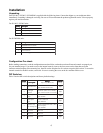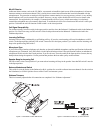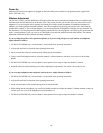
8
Headset Connector Notes
If you are using a monaural, dynamic-mic headset, or a monaural, telephone-style, dynamic-mic handset, or a handheld
dynamic microphone, plug it into the Headset connector. You can also use this connector with monaural headphones for
listening when you are using either the built in panel microphone, or the optional gooseneck microphone for talk back.
Panel Mic Connector Notes
As an alternative to a headset or telephone-style handset, you can use either the built-in panel microphone or an optional
gooseneck microphone. To connect a Telex MCP-90 gooseneck microphone, insert the 1/4” TRS connector into the panel
microphone connector and screw the microphone in. When a gooseneck microphone is inserted in the panel microphone
connector, the built-in panel microphone is automatically bypassed. Use either of these microphones for talk back, then use
the internal speaker for listening, or connect a pair of headphones to the headset connector for private listening.
Intercom Channel Connections
the method of connection depends on the type of box. The “S” box, “P” box, and RM versions connect to the intercom system
using prefabricated cables in a phantom-powered configuration. The “U” box version is designed for permanent installation,
and it can be either phantom powered or locally powered.
Description of Phantom Powered Connection
Figure 5 - An example of a phantom powered system. In this system a PS-2001L power supply is set to isolate mode. In this mode each
channel is a separate party line and current per channel is limited to 1 amp. Note that both single and two channel intercom stations may be
connected by using “Y” cables (or JB2 Junction boxes). Prefabricated cables may be used, or cables may be constructed using the diagrams
in FIgure 11.
In this method, operating power and intercom audio for the entire intercom system ware carried over the same wires. The
advantage of this method is simplicity of connection. The system power supply (PS-2001L, SPS-2001A) etc.) automatically
provides what is know as a terminating impedance for the intercom system. Without this terminating impedance, the sound
quality will be distorted, and the levels will shift every time additional stations are connected. The disadvantage of the
phantom power method is that some operating power is lost over very long intercom cables, and performance at distant


















